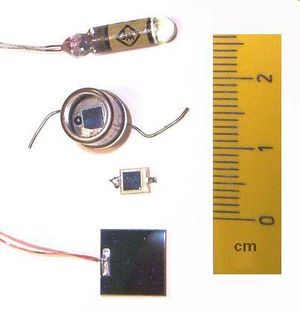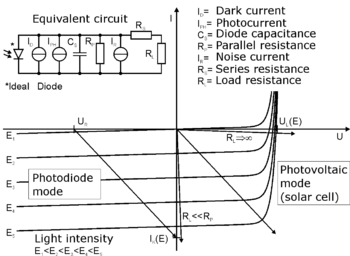ثنائي ضوئي
الثنائي الضوئي photodiode هو نوع من المكشاف الضوئي يمكنه تحويل الضوء إلى تيار أو جهد كهربائي، حسب نوع العملية.[1] الخلية الشمية التقليدية التي تستخدم لتوليد الطاقة الكهربية الشمسية ما هي إلا مساحة كبيرة من الثنائي الضوئي.
مبدأ التشغيل
يقوم مبدأ هذه النبيطة على المفعول الكهروضوئي، فحين يسقط شعاع الضوء على النبيطة وتحديدا على منطقة العزل المكشوفة، فإن الفوتونات إذا امتلكت طاقة كافية لتجاوز فجوة النطاق فإنها تمنح طاقتها للإلكترون ليتمكن من كسر الرابطة التساهمية ويقفز من نطاق التكافؤ إلى نطاق التوصيل، بدوره سيخلف هذا الإلكترون فجوة إلكترونية ما يؤدي بالنهاية إلى مرور تيار مستمر بفضل ثنائي إلكترون-فجوة.
تتم عملية منح الطاقة بواسطة التآثر الكهرومغناطيسي، ويمكن التوصل إلى تركيز تلكم الإلكترونات والفجوات التي ستشكل التيار الضوئي عن طريق دراسة كثافة المستويات في نطاقي التكافؤ والتوصيل لحديد الأماكن الشاغرة في كلا النطاقين ومن ثم تعيين الطاقة الضوئية الساقطة لكل فوتون عن طريق:
طاقة الفوتون = ثابت بلانك * التردد
بعد ذاك يجري الاستعانة بإحصاء فيرمي ديراك لتحديد احتمالية أن يقوم الإلكترون بتلقف طاقة الفوتون الساقط بما يعينه على تخطي فجوة النطاق والوصول لذلك المكان الشاغر.
الجهد الضوئي
التوصيل الضوئي
عمليات أخرى
Avalanche photodiodes have a similar structure to regular photodiodes, but they are operated with much higher reverse bias. This allows each photo-generated carrier to be multiplied by avalanche breakdown, resulting in internal gain within the photodiode, which increases the effective responsivity of the device.
A phototransistor is in essence a bipolar transistor encased in a transparent case so that light can reach the base-collector junction. The electrons that are generated by photons in the base-collector junction are injected into the base, and this photodiode current is amplified by the transistor's current gain β (or hfe). If the emitter is left unconnected, the phototransistor becomes a photodiode. While phototransistors have a higher responsivity for light they are not able to detect low levels of light any better than photodiodes.[بحاجة لمصدر] Phototransistors also have significantly longer response times.
المواد
The material used to make a photodiode is critical to defining its properties, because only photons with sufficient energy to excite electrons across the material's bandgap will produce significant photocurrents.
Materials commonly used to produce photodiodes include[2]:
| المادة | الطيف الكهرومغناطيسي مدة طول الموجة (ن.م) |
|---|---|
| سليكون | 190–1100 |
| جرمانيوم | 400–1700 |
| Indium gallium arsenide | 800–2600 |
| رصاص (II) sulfide | <1000–3500 |
Because of their greater bandgap, silicon-based photodiodes generate less noise than germanium-based photodiodes.
ثنائي الضوء غير مرغوب فيه
السمات
Critical performance parameters of a photodiode include:
مقارنته مع المضخمات الضوئية
Advantages compared to photomultipliers[3]:
- Excellent linearity of output current as a function of incident light
- Spectral response from 190 nm to 1100 nm (silicon), longer wavelengths with other semiconductor materials
- Low noise
- Ruggedized to mechanical stress
- Low cost
- Compact and light weight
- Long lifetime
- High quantum efficiency, typically 80%
- No high voltage required
Disadvantages compared to photomultipliers:
- Small area
- No internal gain (except avalanche photodiodes, but their gain is typically 102–103 compared to up to 108 for the photomultiplier)
- Much lower overall sensitivity
- Photon counting only possible with specially designed, usually cooled photodiodes, with special electronic circuits
- Response time for many designs is slower
مصفوفة الثنائي الثوئي
A one-dimensional array of hundreds or thousands of photodiodes can be used as a position sensor, for example as part of an angle sensor.[4] One advantage of photodiode arrays (PDAs) is that they allow for high speed parallel read out since the driving electronics may not be built in like a traditional CMOS or CCD sensor.
انظر أيضاً
- إلكترونيات
- فجوة النطاق
- أشعة تحت الحمراء
- Optoelectronics
- Optical interconnect
- Light Peak
- Interconnect bottleneck
- كابل ألياف بصرية
- Optical communication
- Parallel optical interface
- Opto-isolator
- Semiconductor device
- خلية شمسية
- Avalanche photodiode
- Transducer
- LEDs as Photodiode Light Sensors
- Light meter
- Image sensor
المراجع
- ^ IUPAC, Compendium of Chemical Terminology, 2nd ed. (the "Gold Book") (1997). Online corrected version: (2006–) "Photodiode".
- ^ Held. G, Introduction to Light Emitting Diode Technology and Applications, CRC Press, (Worldwide, 2008). Ch. 5 p. 116. ISBN 1-4200-7662-0
- ^ Photodiode Technical Guide on Hamamatsu website
- ^ Wei Gao (2010). Precision Nanometrology: Sensors and Measuring Systems for Nanomanufacturing. Springer. pp. 15–16. ISBN 978-1-84996-253-7.
- Gowar, John, Optical Communication Systems, 2 ed., Prentice-Hall, Hempstead UK, 1993 (ISBN 0-13-638727-6)


